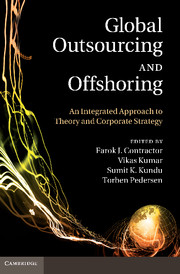Book contents
- Frontmatter
- Contents
- List of figures
- List of tables
- List of boxes
- Notes on contributors
- Preface: the reconfiguration of the world economy
- Part I Conceptual frameworks and theories
- Part II The offshoring and outsourcing of R&D and innovative activities
- Part III Management issues in offshoring and virtual teamwork
- 10 Changing work practices
- 11 Managing globally disaggregated teams
- Part IV Empirical analyses and case studies of outsourcing and offshoring
- Index
- References
10 - Changing work practices
Acceptance of virtual work among knowledge professionals engaged in offshoring activities
Published online by Cambridge University Press: 10 January 2011
- Frontmatter
- Contents
- List of figures
- List of tables
- List of boxes
- Notes on contributors
- Preface: the reconfiguration of the world economy
- Part I Conceptual frameworks and theories
- Part II The offshoring and outsourcing of R&D and innovative activities
- Part III Management issues in offshoring and virtual teamwork
- 10 Changing work practices
- 11 Managing globally disaggregated teams
- Part IV Empirical analyses and case studies of outsourcing and offshoring
- Index
- References
Summary
Introduction
Technological advances and economic changes have increasingly motivated and enabled distant collaboration between knowledge workers (Hinds and Kiesler, 2002). Offshoring of professional services (software development, financial services, radiology reads, R&D) to emerging countries provides a renowned example of this trend (Friedman, 2005; Levy, 2005; Venkatraman, 2004). Notwithstanding the alleged numerous advantages for Western organizations – including cost savings, reduction of time to market, access to worldwide expertise, easier penetration in local markets, increased codification of internal processes (e.g., Farrel, 2006; Gupta et al., 2007) – knowledge workers likely perceive offshoring as a cause of turmoil.
A first source of disruption stems from distance – both geographical and cultural – between knowledge workers. A geographically dispersed or globally distributed team (GDT) is defined as a group of individuals: (i) belonging to one or more organizations; (ii) interdependent and driven by a common purpose; (iii) using technology-supported communication more than face-to-face communication; and (iv) based in different countries (Lipnack and Stamps, 1997). Maznevski and Chudoba (2000) integrate this definition by observing that GDTs are also global in their tasks and are responsible “for making and/or implementing decisions important to the organization's global strategy” (p. 473). The literature on GDTs explores the challenges of distant collaboration between geographically and culturally distant members, such as compatibility with existing hierarchical structures (Mohrman, 1998), increased coordination costs (Boh et al., 2009), awareness of other team members' activities (Dourish and Bellotti, 1992), trust (Paul and McDaniel, 2004), socialization processes (Ahuja and Galvin, 2003), and leadership (Weisband, 2002).
Information
- Type
- Chapter
- Information
- Global Outsourcing and OffshoringAn Integrated Approach to Theory and Corporate Strategy, pp. 267 - 296Publisher: Cambridge University PressPrint publication year: 2010
